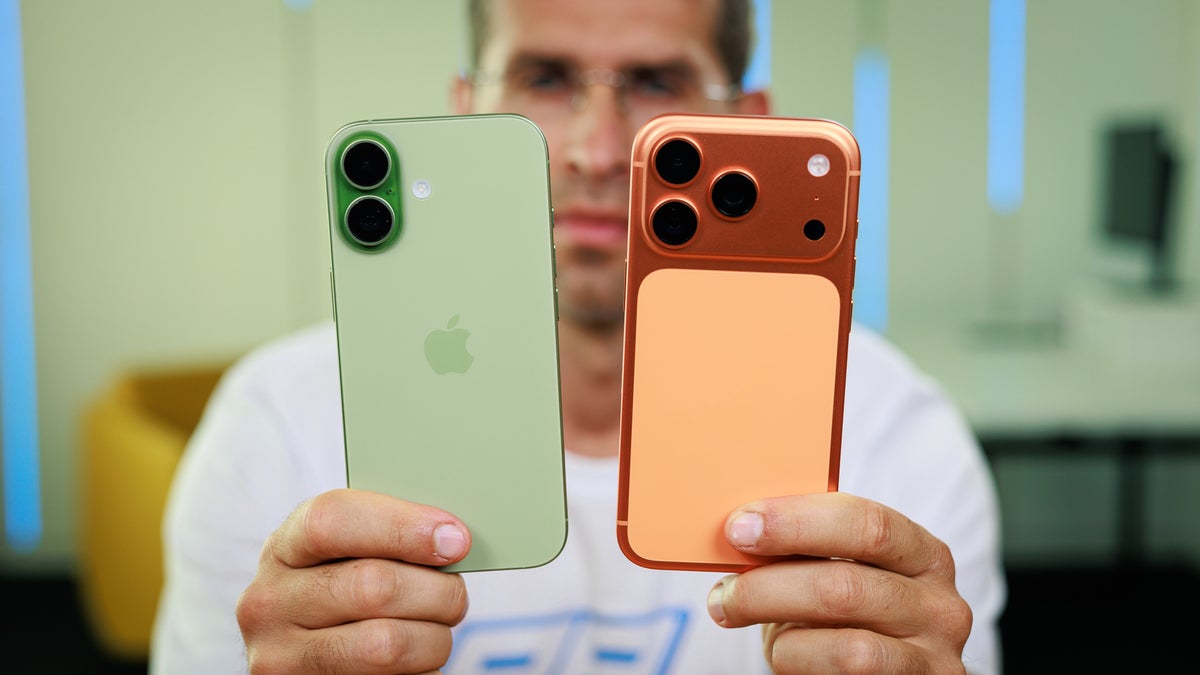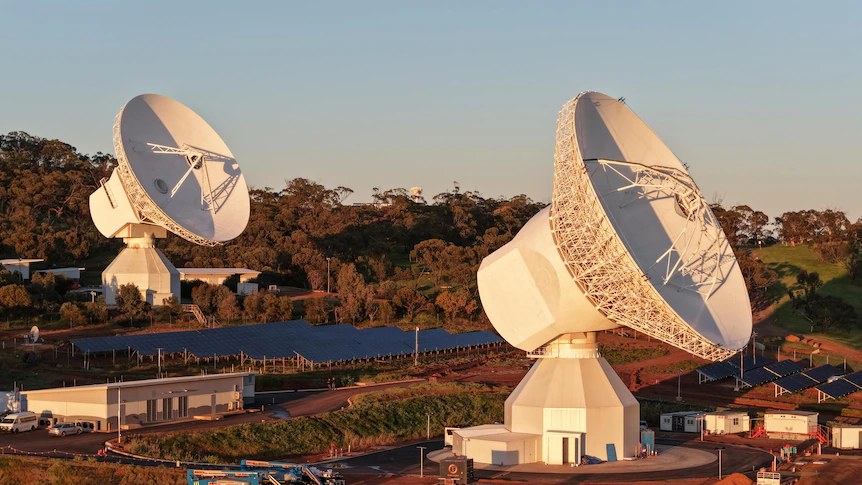
A 120Hz screen, new cameras, more storage, same price: the iPhone 17 sounds almost too good to be true.
We may earn a commission if you make a purchase from the links on this page.
The iPhone 17 brings a 120Hz ProMotion display, a new 48 MP ultrawide camera, and a sharper 18 MP Center Stage selfie camera.
But you might be asking yourself: how does it stack up against the iPhone 17 Pro, a phone that adds a 48 MP 4X telephoto, vapor-chamber cooling, and creator-grade video tools?
If you already own the iPhone 17 Pro (or if you’re choosing between the two today) the big question is whether the iPhone 17 offers enough for less, or if the Pro gives you features you’ll actually use.
To find out, we put both phones through our in-house tests for battery life, camera quality, display performance, and raw speed. Beyond the numbers, we also lived with them to see how they behave day-to-day. In this detailed comparison, we’ll share our results and help you decide which phone is the smarter choice for your needs.
iPhone 17 Pro: $0.00/mo. at Verizon
$0 /mo
$30 55
$31 off (100%)
The powerful iPhone 17 Pro is finally here! You can now get the new Pro with an upgraded design and a brilliant display for as low as $0.00/mo. at Verizon. You must set up a new line on an Unlimited Ultimate plan and trade in a device to take advantage.
Buy at Verizon
iPhone 17 Pro Max: $2.77/mo. at Verizon
$2 77 /mo
$33 33
$31 off (92%)
The impressive iPhone 17 Pro Max is available at Verizon. Right now, you can save up to $1,100 on the premium device when you activate a new line and trade in an eligible device. The promo is only available with an Unlimited Ultimate plan.
Buy at Verizon
iPhone 17: $0.00/mo. at Verizon
$0 /mo
$23 05
$23 off (100%)
Get the iPhone 17 and enjoy improved design, better battery life, and top-tier performance. Right now, you can get the phone for $0.00/mo. with Unlimited Welcome, Unlimited Plus or Unlimited Ultimate plan.
Buy at Verizon
iPhone Air: $0.00/mo. at Verizon
$0 /mo
$27 77
$28 off (100%)
The slimmest iPhone is here! You can now buy the powerful iPhone Air at Verizon for $0.00/mo. with a new line activation on select Unlimited plans and a trade-in. This is an online-only offer.
Buy at Verizon
iPhone 17 vs iPhone 17 Pro differences:
7.7
Apple iPhone 17
7.9
Apple iPhone 17 Pro
5.9
7.6
6.8
6.1
7.6
8.6
8.5
8
8.2
8
8
10
Battery Life
Photo Quality
Video Quality
Charging
Performance Heavy
Performance Light
Display Quality
Design
Wireless Charging
Biometrics
Audio
Software
6.7
8
7.1
6
8.3
8.7
8.5
8
8
8
8
10
Table of Contents:
Design and DisplayPerformance and SoftwareCameraBatteryAudioSpecsConclusion
Read more:
iPhone 17 vs iPhone 16eiPhone 17 vs iPhone 15iPhone 17 vs iPhone 16
Design and Size
Ceramic Shield 2 protection, slimmer bezels, and a new Pro look
Unlike the Pro model, the iPhone 17 has the same look as its predecessor. It’s also still rocking an aluminum frame and a glass back, but introduces Ceramic Shield 2 on the front, which Apple says is three times more scratch resistant than before. The back remains reinforced glass.
The iPhone 17 Pro moves away from last year’s titanium and also adopts an aluminum body. Apple highlights this as a lighter, stronger, and more thermally efficient approach, as it integrates the new vapor chamber cooling system directly into the frame.
Unlike the base model, the Pro is protected by Ceramic Shield 2 on both the front and the back, making it more resistant to scratches and cracks. That said, you’ll quickly come to find that anything besides the glass part on the Pro’s back is pretty easily chipped and scratched, so if you want it to stay prestine and keep its resale value, you better slap on a case on it.
Receive the latest Apple news
By subscribing you agree to our terms and conditions and privacy policy.
The Pro also debuts a redesigned rectangular “camera plateau”, which houses its triple 48 MP camera system and sets it apart visually from the dual-camera iPhone 17.
When it comes to size and weight, the iPhone 17 comes in at 149.6 x 71.5 x 7.95 mm and weighs 177 grams. The iPhone 17 Pro is slightly taller, wider, and thicker at 150.0 x 71.9 x 8.75 mm, and it’s also noticeably heavier at 206 grams. You can feel the Pro’s heft when you hold it, but both feel similar in the hand as far as ergonomics go.
The iPhone 17 and 17 Pro colors:
iPhone 17: Black, Lavender, Mist Blue, Sage, WhiteiPhone 17 Pro: Black, Silver, Gold, and a new standout Orange
One of the biggest upgrades this year is that the iPhone 17 now has a 120Hz ProMotion OLED display. Apple withheld this feature for years, leaving the base iPhones stuck at 60Hz, but it’s finally here. The result is smoother scrolling, animations, and gaming.
Both models use 6.3-inch OLED panels with the same resolution (2622 × 1206, 460 ppi) and peak brightness of 3000 nits outdoors, making them much easier to read under sunlight compared to the 2000 nits of the iPhone 16 series. In HDR content, both peak at 1600 nits, and typical brightness remains 1000 nits.
Apple even added LTPO technology to the new base model, allowing the refresh rate to scale down to 1Hz. This unlocks Always-On Display support and greater power efficiency.
Apple has added a seven-layer anti-reflective coating to the iPhone 17 series.
It is not quite as effective as the coating on the Galaxy S25 Ultra, but it noticeably reduces reflections compared to the iPhone 16 series.
Display Measurements:
n
Bright max(20%APL)Higher is betterBright max(100%APL)Higher is betterBright minLower is betterColor tempGammaDelta E rgbcmyLower is betterDelta E grayscaleLower is betterApple iPhone 172672
(Excellent)1054
(Good)1.5
(Good)6844
2.19
1.85
(Excellent)5.35
(Average)Apple iPhone 17 Pro2780
(Excellent)1043
(Good)0.9
(Excellent)6656
2.22
1.81
(Excellent)4.96
(Average)View all
Color gamutColor accuracyGrayscale accuracy
The CIE 1931 xy color gamut chart represents the set(area)of colors that a display can reproduce,with the sRGB colorspace(the highlighted triangle)serving as reference.The chart also provides a visual representation of a display’s color accuracy. The small squares across the boundaries of the triangle are the reference points for the various colors, while the small dots are the actual measurements. Ideally, each dot should be positioned on top of its respective square. The ‘x:CIE31’ and ‘y:CIE31’ values in the table below the chart indicate the position of each measurement on the chart. ‘Y’ shows the luminance (in nits) of each measured color, while ‘Target Y’ is the desired luminance level for that color. Finally, ‘ΔE 2000′ is the Delta E value of the measured color. Delta E values of below 2 are ideal.
These measurements are made using Portrait Displays’ CalMAN calibration software.
Apple iPhone 17Apple iPhone 17 Pro
The Color accuracy chart gives an idea of how close a display’s measured colors are to their referential values. The first line holds the measured (actual) colors, while the second line holds the reference (target) colors. The closer the actual colors are to the target ones, the better.
These measurements are made using Portrait Displays’ CalMAN calibration software.
Apple iPhone 17Apple iPhone 17 Pro
The Grayscale accuracy chart shows whether a display has a correct white balance(balance between red,green and blue)across different levels of grey(from dark to bright).The closer the Actual colors are to the Target ones,the better.
These measurements are made usingPortrait Displays’ CalMAN calibration software.
In our lab results, both models achieved above 2,600 at 20%APL and roughly 1,050 nits while the screen is completely white. Color accuracy remains top-tier, with Delta E values below 1.2 in True Tone mode.
Recommended Stories
Performance and Software
A19 vs A19 Pro, USB 2 vs USB 3, 8 GB vs 12 GB RAM
Both phones run on Apple’s latest 3nm chips, but the Pro uses the more powerful A19 Pro. The A19 chip inside the iPhone 17 has a 6-core CPU (2 performance, 4 efficiency), a 5-core GPU, and a 16-core Neural Engine. The A19 Pro adds a 6-core GPU, giving it more headroom for gaming, creative work, and Apple Intelligence features.
The Pro also gains a vapor chamber cooling system, allowing it to sustain peak performance for longer without overheating, which will be noticable when gaming or doing a lot of video recording and editting, for example. That said, Apple’s vapor chamber is a passive system, which means it doesn’t actively cool the phone, but rapidly spreads heat across the chassis to delay throttling under sustained loads.
The iPhone 17 comes with 8 GB of RAM and storage up to 512 GB storage, while the Pro is equipped with 12 GB of RAM and offers storage up to 1 TB (both start at 256 GB). That makes the Pro better suited for workflows that include larger files.
CPU Performance Benchmarks:
Geekbench 6
SingleHigher is better
Apple iPhone 173527Apple iPhone 17 Pro3668
Geekbench 6
MultiHigher is better
Apple iPhone 178798Apple iPhone 17 Pro9498View all
The iPhone 17 Pro performed only marginally better than the standard iPhone 17 in our Geekbench tests, showing little to no benefit of going for the A19 Pro chipset when it comes to CPU performance.
GPU Performance
3DMark Extreme(High)Higher is better
Apple iPhone 175172Apple iPhone 17 Pro5914
3DMark Extreme(Low)Higher is better
Apple iPhone 173295Apple iPhone 17 Pro3506View all
In our testing, the iPhone 17 Pro maintains 65–70% performance stability in the 3DMark stress test — far better than the regular iPhone 17, which begins throttling sooner under load. That translates to smoother sustained frame rates in demanding games like Resident Evil 4 and Death Stranding, both now playable at nearly 50fps on the Pro.
Another important difference is the USB-C port. The iPhone 17 only supports USB 2 speeds, meaning file transfers are limited. The iPhone 17 Pro supports USB 3 at up to 10Gbps, making it much faster for moving ProRes video or large files.
On the software side, both models ship with iOS 26, which introduces the new Liquid Glass design language, Live Translate, Call Screening, and the first wave of Apple Intelligence features.
Camera
Dual 48 MP vs triple 48 MP
Apple finally upgraded the base iPhone’s secondary camera: alongside the 48 MP main image sensor from last year, the iPhone 17 now uses a 48 MP ultrawide. Image quality has improved mostly when it comes to detail, which also affects the Macro mode.
The new 48 MP ultrawide now defaults to 24 MP images. The good news is that the iPhone 16 Pro and Pro Max also get 24 MP default photos with the iOS 26 update.
At the front, both phones share Apple’s new 18 MP Center Stage selfie camera with a wider field of view, auto-expanding/auto-rotating framing for group selfies, and noticeably better video stabilization, even in 4K HDR.
Where the Pro truly separates itself is the new 48 MP telephoto camera. It uses a tetraprism design and a larger sensor (56% larger than before) to deliver 4x optical zoom at 100 mm and an extended 8x at 200 mm, with up to 40x digital for photos. There is an obvious step up in detail at 4x, and even at 5x the new 48 MP telephoto produces cleaner, higher-resolution results than the old 5x image sensor.
At 2x, the Pro also shows better detail thanks to cropping from its larger main sensor. The 4x lens can focus a bit closer than the previous 5x, which helps for product shots and food pics, but the focus distance still doesn’t seem to be close enough for true telephoto-macro shots.
Portrait mode sees a substantial improvement on both models: the 48 MP pipeline now preserves facial detail and skin texture far better than the iPhone 16 generation, avoiding that waxy look.
There aren’t many notable changes to video recording on the base model, but the Pro adds new tools for creators like ProRes RAW (requires an external drive), Apple Log, Opengate, and Genlock.
For video, both support Dolby Vision HDR, Cinematic mode, Action mode, and Dual Capture. The Pro, however, unlocks more advanced tools: 4K120 ProRes, ProRes RAW, Apple Log, Academy Color Encoding System, and Genlock support, all of which are features aimed squarely at professionals.
PhoneArena Camera Score:
Photo
Video
Phone Camera
Score Photo
Score Main
(wide) Ultra
Wide Selfie Zoom Apple iPhone 17 150 156 84 24 28 21 Apple iPhone 17 Pro 156 162 84 24 28 26
Phone Camera
Score Video
Score Main
(wide) Ultra
Wide Selfie Zoom Apple iPhone 17 150 145 77 23 26 18 Apple iPhone 17 Pro 156 150 77 23 26 24
Find out more details about photo and video scores for all phones we have tested on our PhoneArena Camera Score page
In our lab testing, the iPhone 17 Pro scored slightly higher overall thanks to sharper zoom detail and improved main-camera consistency. Both models performed similarly when it came to color acuracy and HDR performance, though the Pro holds an advantage in low-light conditions due to its larger main image sensor.
Main Camera
< iPhone 17 iPhone 17 Pro >
Zoom Quality
< iPhone 17 4x iPhone 17 Pro 10x >
< iPhone 17 4x iPhone 17 Pro 10x >
Ultra-wide Camera
< iPhone 17 iPhone 17 Pro >
Selfies
< iPhone 17 iPhone 17 Pro >
Video quality comparison coming soon.
Battery Life and Charging
Bigger batteries, faster charging
Both iPhones use stacked battery technology for better energy density and durability. The iPhone 17 comes with a ~3,692 mAh battery, while the iPhone 17 Pro is slightly larger at ~3,988 mAh (Nano SIM) or ~4,252 mAh (eSIM). Keep in mind that battery sizes are not confirmed yet, so take these with a grain of salt.
Apple rates the iPhone 17 for up to 30 hours of video playback (27 streamed), while the Pro lasts up to 33 hours (30 streamed). These are Apple’s best runtimes yet for this size.
PhoneArena Battery and Charging Test Results:
Battery Life
Charging
Phone Battery Life
estimate Browsing Video Gaming Apple iPhone 17
3692 mAh
6h 13min 16h 47min 7h 19min 9h 12min Apple iPhone 17 Pro
4252 mAh
6h 42min 17h 6min 8h 25min 10h 8min
Phone Full Charging 30 min Charge Wired Wireless Wired Wireless Apple iPhone 17
3692 mAh
1h 16min Untested 67% Untested Apple iPhone 17 Pro
4252 mAh
1h 16min Untested 67% Untested
Find out more details about battery and charging for all phones we have tested on our PhoneArena Battery Score page
In our tests, the iPhone 17 delivered around 16 hours and 47 minutes of web browsing and 7 hours and 19 minutes of YouTube streaming. The iPhone 17 Pro extended that slightly with about 17 hours and 10 minutes of browsing and 8 hours and 25 minutes of video streaming. Both, however, are good enough for a day of normal use.
Charging speeds have also improved. With Apple’s new 40W Dynamic Power Adapter, both models can reach 50% in about 20 minutes. Wireless charging remains capped at 25W, but both phones now support Qi2, so third-party magnetic chargers can finally match MagSafe’s top speeds.
Both models support reverse wired charging, but still no reverse wireless charging, even on the Pro.
Audio Quality and Haptics
The iPhone 17 produces clean, full audio with a good sense of depth and bass, making it enjoyable for music, videos, and podcasts. The iPhone 17 Pro sounds equally clear, but it doesn’t reach quite the same maximum loudness as last year’s Pro model. That said, it still sounds somewhat better than the standard model.
Haptics are identical on both phones. Apple’s Taptic Engine continues to set the standard for precision feedback, with tight, well-tuned vibrations that make notifications and gestures feel immediate and satisfying.
Specs Comparison
Here’s a quick overview of the iPhone 17 vs iPhone 17 Pro specs.
Which one should you buy?
The iPhone 17 finally feels like the iPhone most people wanted years ago. With a 120Hz display, brighter screen, 48 MP ultrawide, and 18 MP Center Stage selfie camera, it should now be the go to iPhone for anyone who isn’t looking for those very special and niche Pro fetures on the iPhone 17 Pro. Not to mention that you get 256 GB of storage for the same price as last year’s base model.
The iPhone 17 Pro, on the other hand, lives up to its name more than any other Pro iPhone that came before it. Not so much for its chip performance, but mainly because of its camera system and the features tied to it. There’s also the new vapor chamber cooling, which keeps the phone from heating up when using its Pro-centric features like ProRes RAW, Apple Log, Genlock, and more. It is clearly the iPhone for professionals.
For most people, though, the regular iPhone 17 seems to cover the essentials so well that the Pro is harder to justify. Unless you need pro-grade video tools, extended zoom, or 1TB of storage, the base iPhone 17 is the one that finally has you covered.
Follow us on Google News
Recommended Stories
FCC OKs Cingular\’s purchase of AT&T Wireless



